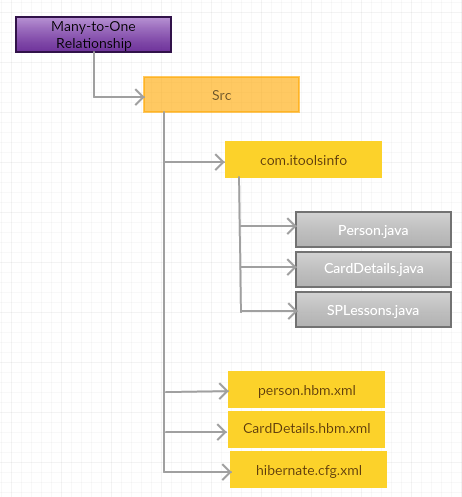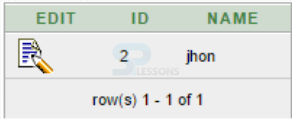 Description
Description
Hibernate Many to One, if the child class object is loaded from the database, Then automatically parent class object also loaded into the database. In Many-to-One Relationship, a parent class object will be set to the multiple objects of the child class. When creating a child POJO class, create a reference variable of type parent class in the child POJO class.
 Example
Example
In this example, take the details of a Person containing multiple card details like Adharcard and voterId card. let's make the Parent class as Person and child class as CardDetails.
- Create the project directory structure.
- Create the persistence classes.
- Map the persistence classes in mapping file.
- Configure the mapping files in Configuration file.
| Properties | Description |
|---|---|
| hibernate.connection.driver_class | The JDBC driver class. |
| hibernate.dialect | This property makes Hibernate generate the suitable SQL for the picked database. |
| hibernate.connection.url | The JDBC URL to the database instance. |
| hibernate.connection.username | The database username. |
| hibernate.connection.password | The database password. |
| hibernate.connection.pool_size | Limits the number of connections waiting in the Hibernate database connection pool. |
| hibernate.connection.autocommit | Allows autocommit mode to be used for the JDBC connection. |
- Create the SPLessons class and store the POJO class objects to perform the database operations.
In Many-to-One annotation, one have to use the @manyToOne(cascade=CascadeType.ALL) annotation.
- Create the project directory structure.
- Create the persistance classes.
- Configure the persistence classes in Configuration file.
| Properties | Description |
|---|---|
| hibernate.connection.driver_class | The JDBC driver class. |
| hibernate.dialect | This property makes Hibernate generate the suitable SQL for the picked database. |
| hibernate.connection.url | The JDBC URL to the database instance. |
| hibernate.connection.username | The database username. |
| hibernate.connection.password | The database password. |
| hibernate.connection.pool_size | Limits the number of connections waiting in the Hibernate database connection pool. |
| hibernate.connection.autocommit | Allows autocommit mode to be used for the JDBC connection. |
- Create the SPLessons class and store Persistence class objects to perform the database operations.
 Key Points
Key Points
- Hibernate Many to One - lazy attribute is utilized in Many-to-One relationship.
- lazy attribute either may be proxy or false.
- If lazy attribute is false then child object is loaded, immediately parent object will also be loaded from the database.
- Hibernate Many to One - If lazy attribute is proxy then parent object will not be loaded immediately.








